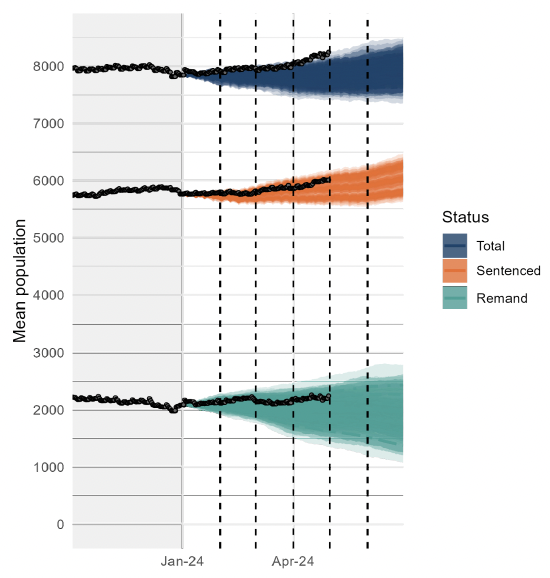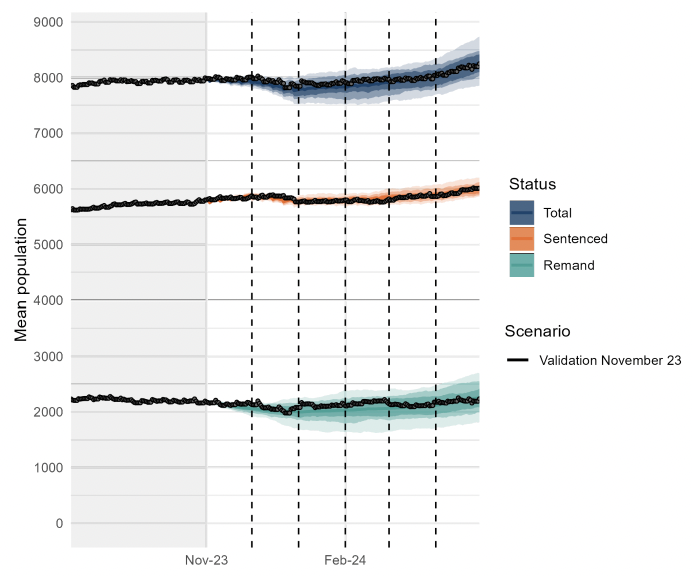Scottish Prison Population Projections: June 2024 Edition
This report presents short-term Scottish prison population projections for the six month period from May to October 2024. They have been produced using ‘microsimulation’ scenario modelling which simulates prison arrivals and departures, and estimates the number of individuals in prison.
4 Introduction to Prison Population Projections
This section provides an overview of the assumptions and scenarios developed to project the prison population and explains how the model’s previous projections are validated for robustness against actual prison population figures in recent months. The first issue of the Scottish prison population projections[28] provides a more detailed overview of the modelling technique used.
Model Assumptions and Scenarios
The projection scenarios are based on a variety of assumptions about how the rate of transitions into and out of the prison population might change. The assumptions depend on trends and planned changes to the court system, including court capacity changes, increased court conclusions rate, increased remand arrivals, remand/bail mix and prioritisation of remand case progression through courts. Departures from the sentenced population are estimated using a combination of court disposal data and snapshots of the prison population.
For the first issue (June 2023) of the Scottish prison population projections[29] only three scenarios were developed, using central remand arrivals and either low, central or high court throughput. Due to the heightened level of inflows and outflows which contributed to growth in the sentenced and remand populations in mid-2023, additional scenarios were developed and added to the projections from November 2023 onwards. These six additional scenarios featured alternative remand arrivals assumptions (low and high) combined with the three levels of court throughput (low, central and high) were introduced from November 2023[30]. A full breakdown of all nine scenarios is given in Table 1. This set of scenarios was developed to help account for uncertainty in future remand arrivals.
The three variations of remand arrivals assumptions used for the scenarios are: central, higher and lower. The central remand arrivals scenario assumes remand arrivals will be similar over the next few months to what they were between April 2023 and March 2024. For the previous edition of the projections the higher remand arrivals assumptions were based on the 6-month period with the highest remand arrivals since 2020 (i.e., March to August 2023), during which time average monthly remand arrivals were around 820 per month. Since those projections were published, remand arrivals have been elevated, and the average monthly remand arrivals during the 3-month period from February to April 2024 was 830. Therefore, for this edition of the projections the high remand scenario assumptions have been updated with the latest information and are based on the higher remand arrivals from the period from February to April 2024. This should ensure that the modelling for the projections has accounted for the possibility that remand arrivals could be sustained at a higher level than was assumed for the previous edition of the projections.
For the previous edition the low remand arrivals assumptions were based on the six-month period from October 2022 to March 2023. For this edition of the publication the assumptions have been updated with more recent data from September to November 2023, which was the contiguous 3-month period in the last 12 months with the lowest remand arrivals (December 2023 is excluded due to atypical seasonal flows which are very unlikely to be repeated during the next 6 months). The use of higher estimates for remand arrivals should help account for some of the uncertainty around the level of remand arrivals in 2024, given the exceptionally high levels recently.
Furthermore, to help with understanding how sensitive the size of the prison population may be to variations in court case conclusion rate, three variants have again been included in the modelling - central, higher, and lower throughput. The “central” court throughput scenario variant assumes case conclusion rates per courtroom which are based on data covering May 2023 to April 2024. The “higher” scenario assumes the average case throughput per court will be slightly greater than it has been over the same period, and the “lower” scenario assumes that the average case throughput per court will be slightly smaller. The nine scenario variants shown in table 1 include all the possible combinations of the above variations of court throughput and remand arrivals.
| Scenario | Remand Arrival Rate | |||
|---|---|---|---|---|
| Central | Higher | Lower | ||
| Conclusion rate | Central | 1. Sc1a Central Conclusions & Central Remand Arrivals | 4. Sc2a Central Conclusions & Higher Remand Arrivals | 7. Sc3a Central Conclusions and Lower Remand Arrivals |
| Higher | 2. Sc1b Higher Conclusions and Central Remand Arrivals | 5. Sc2b Higher Conclusions & Higher Remand Arrivals | 8. Sc3b Higher Conclusions and Lower Remand Arrivals | |
| Lower | 3. Sc1c Lower Conclusions & Central Remand Arrivals | 6. Sc2c Lower Conclusions & Higher Remand Arrivals | 9. Sc3c Lower Conclusions and Lower Remand Arrivals | |
Since the progression of the justice system’s recovery (e.g., rate of reduction of scheduled trials) impacts the model’s assumptions and longer-term predictive power, the projections cover a limited period, from May 2024 to October 2024.
Model Quality Assurance
At each update, the previous projections are compared with the actual population to determine the model’s suitability for continuing to provide reliable projections. Figure 13 shows the January 2024 projections from the microsimulation, which were published in February 2024[31]. Even after accounting for a wide variety of uncertain dynamics in the system, Figure 13 indicates that the projected ranges for the remand, sentenced and total populations have reasonably accurately aligned with the actual levels for the majority of the projection. The actual total population tracked above the projection range upper estimate on a small number of days in April 2024. This was because the actual prison population growth rate was higher in April 2024 than at any time during 2023 (the period which was used to develop the modelling assumptions). Solemn court procedure throughput was high in recent months (see Figure 7) and contributed to strong growth in the sentenced population (it was in the upper part of the range in April 2024). The remand population at the end of April was also in the upper half of the projection range, mainly due to high remand arrivals. In future, the modelling will use a wider range of remand arrival assumptions, informed by very recent data, to give projections which should account for the potential for another period of very high population growth similar to that in April 2024.

To check the model further, back-casting is used to retrospectively compare the actual prison population for the past few months against a projection generated by the model based on actual monthly court throughput data. The back-cast eliminates uncertainty about the majority of the assumptions, so if there was a difference between the back-cast and the actuals it may indicate technical deficiencies in the model. The recent back-cast projections presented in Figure 14 show that the back-cast from November 2023 to April 2024 is largely accurate.

Microsimulation Model Limitations
The model relies on the availability of a large amount of frequently refreshed high-quality data about court activity and prison populations, some of which can be resource intensive to obtain and process.
The model does not currently simulate flows for different crime-types, so crime-based trends are not explicitly modelled. However, there are plans to develop the model further and include case-mix in future modelling.
Contact
Email: Justice_Analysts@gov.scot
There is a problem
Thanks for your feedback